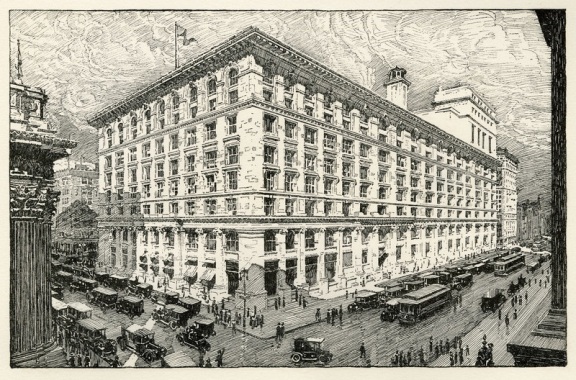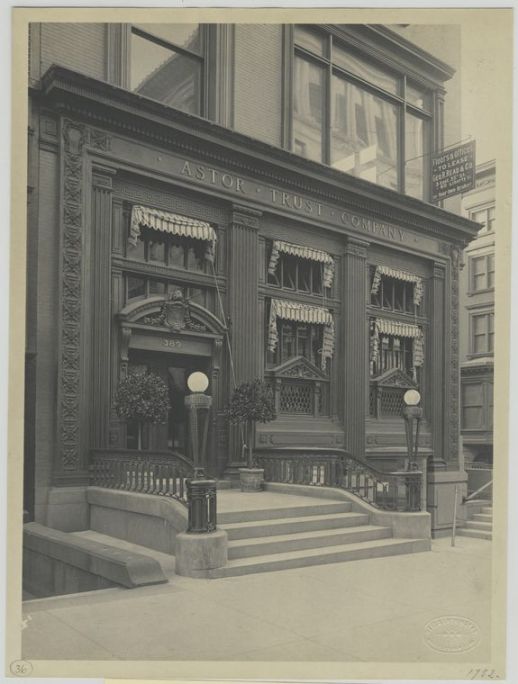Starting at the bottom of this map section, we start with the most obvious landmark: “B. Altman and Co. Department Store.”

1916 map: between 5th and Madison Avenues, from 34th to 35th Streets. At this point, the entire block is occupied by B. Altman Department Store. The dotted lines here represent additions built after 1906 as the store devoured its neighbors. (Photo from the NYPL Digital Gallery)
Founded in 1865 by native New Yorker Benjamin Altman, B. Altman started as a humble family-owned dry goods store on the Lower East Side. In 1877, Altman had become so successful that he chose to open a much larger store on 6th Avenue between 18th and 19th Streets on what was quickly becoming the famed “Ladies’ Row” of shopping emporiums. In 1906, Altman yet again chose to leapfrog his competition, foreseeing the continued northward movement of the city’s commercial heart. And so it was that he then constructed his flagship store on 5th Avenue between 34th and 35th Streets, just east of Herald Square in what was then a tranquil and wealthy residential district.

B. Altman as it appeared in 1914. This etching shows its 5th Avenue entrance at left and its long face on 34th Street to the right. (Copyright: Seymour B Durst Old York Library Collection, Avery Architectural Fine Arts Library, Columbia University)
Altman spurred an explosion of retail growth in the area, which remains active to this day. Altman died in 1913, leaving no heir to his fortune. But he wisely deeded his retail empire to a trust in his name, which continued operating the B. Altman chain until 1985. At that point, the trust chose to sell the chain and focus on charitable work. But B. Altman was flipped by a succession of investors over the following years, driving its consumer base away to its competitors and its finances into the ground.
In 1989, the company filed for bankruptcy and by 1990, the last B. Altman store had closed. The 1906 flagship on 5th Avenue, pictured in this map, still stands. A New York City Landmark, it stood abandoned until 1996. That year, its exterior was refurbished and its interior was reconfigured to house the Graduate Center for the City University of New York on the 5th Avenue side, and the New York Public Library and Oxford University Press on the Madison Avenue side.
Moving north on the map, the block between 35th & 36th Streets was mostly residential in 1916:

1916 Map: 5th to Madison Avenues, from 35th to 36th Streets. Kurzman Brothers Millinery and the Alvin Building anchor the block’s 5th Avenue front. The rest of the blocks is residential. (NYPL Digital Gallery)
The most prominent establishment on this block is the building labeled “Kurzman Bros” in the northwest corner. Kurzman Brothers was a luxurious millinery, or hat making-and-selling shop. They are described in the 1907 Millinery Trade Review as being “one of the largest and finest shops of its kind in the country.”
Kurzman Brothers occupied the buildings at 385 and 387 5th Avenue. Both were demolished in 1929 to make way for a new highrise, which still stands. On its ground level are a souvenir shop and a vitamin store: pale substitutes for the luxurious hatmaker that once was.
To the south of the Kurzman building stood “A. Lowenbein’s Sons Furniture Restoration” and “Alice Maynard Ladieswear.” Both buildings were demolished in 1920 to be replaced by the 6-story building which currently stands there today.
379 and 377 5th Avenue were both residences at the time. 375 and 373 (“The Alvin Bldg” on the 1916 map) were home to a combination of a rug shop, furriers and corsette-makers. Today, both residences are gone, but the two commercial buildings on the southwest corner of the block remain. Though their ground floors have been drastically altered – one is a cafe and the other is a Starbucks – they remain mostly untouched above.
The remainder of this block was still residential a century ago, filled with comfortable row houses such as these, which were located at 13, 15, and 17 East 35th Street. They would have looked out their front windows at the B. Altman store.

Homes at 13, 15, and 17 East 35th Street as they appeared in 1916. All were demolished in 1923 for the construction of a 25-story building which stands there today.
Nearly every home on this block was demolished before 1923 for the construction of the 25-story, 385-foot-tall building which still stands there today under the address 200 Madison Avenue.
Moving north again on the map, the block between 5th and Madison Avenues from 36th to 37th Streets was likewise still quite residential, though somewhat more developed than the block to its south:

Anchored on 5th Avenue by Tiffany & Co. Jewelers and two other commercial buildings, this block was well on its way to urbanizing in 1916. (NYPL Digital Gallery)
The largest establishment on this block was the headquarters for Tiffany & Co. Jewelers, which is still a global standard for luxury. Tiffany & Co. was founded in downtown New York by Charles Tiffany. By the time he moved to a new store on Union Square in 1870, his name was already synonymous with luxury. As his company expanded, Tiffany, moved uptown to follow the shifting retail markets of the city’s burgeoning population. And so it was that in 1905, he opened this soaring monument in marble and glass to house his showrooms and design studios.

The Tiffany & Co. headquarters at 5th Avenue & 37th Street, ca 1905. (Copyright, Museum of the City of New York)
Tiffany & Co. would remain here until 1940 when, again following the flow of wealth and commerce, they would move to a new headquarter building on 57th Street, where they remain to this day. Their beautiful old flagship at 37th Street was left abandoned to the ages, as a succession of retail establishments ravaged its elegant ground floor, which is today home to a TD Bank, a souvenir shop, and a Burger King. “The People’s Court” has filmed on a set in the building’s upper floors since 1998. Unworthy successors to one of the world’s greatest jewelry houses and underwhelming tenants for their beautiful old building.

In this photo, the building appears to be under construction, most likely dating it to 1905. This will eventually be the main entrance on 5th Avenue. Today, a TD Bank occupies the left 3 bays, a souvenir shop is in the 4th bay, and a Burger King sits inside the right entrance. (Copyright: Seymour B. Durst Old York Library Collection, Avery Architectural & Fine Arts Library, Columbia University)
Immediately to the south of Tiffany & Co. in 1916 stood “C.G. Gunther’s Sons,” a proud old fur company founded in New York in 1820. A 1959 article in TIME Magazine stated: “In a gilded age when sables were a princess’ best friend, the nation’s best place to buy sables was Manhattan’s C.G. Gunther’s Sons. Founded in 1820 by a German immigrant associated with fur trader John Jacob Astor, Gunther’s not only combed Siberia for the finest sables, but bid in the London market for the finest ermine, sent its agents across Canada on the lookout for mink. Even men coveted the Gunther’s label.”
South of Gunther’s, at the corner of 36th Street and 5th Avenue, stood the “Astor Trust Co.,” a financial institution headed until 1912 by Colonel John Jacob Astor, who perished on the Titanic. Upon his death, his son Vincent inherited his millions and succeeded his place on the Trust’s board.

Photographs showing Tiffany’s, Gunther’s, and Astor Trust in 1911 (L) and today (R). Tiffany’s hosts a Burger King, Gunther’s sells Yankee gear where there used to be world-class furs, and Astor Trust has been long-ago replaced. (1911 photo from NYPL Digital Gallery, current view from Google Maps)
In 1914, the Trust constructed a new 20-story headquarters at 42nd Street and 5th Avenue, which stands to this day, albeit with a brutalized ground floor filled with retail odds-and-ends. The Astors would likely be horrified. In April of 1917, Astor Trust merged with Bankers Trust, which was in turn purchased by Deutsche Bank in 1998 for more than $10 billion. This original Astor Trust building at 36th Street and 5th Avenue was demolished to make way for a new tower in the 1920s, which stands to this day.

The Astor Trust Company at 36th Street & 5th Avenue in 1908. The company would move uptown to 42nd Street in 1914. This location met the wrecking ball not long after. (NYPL Digital Gallery)
The only other labeled building on this block is the “Haviland and Co.” building mid-block between 5th and Madison Avenues, stretching from 36th to 37th Streets. Haviland remains to this day a well-respected manufacturer of Limoges porcelain. Here they built their headquarters in 1906, becoming the first direct-to-consumer sellers of fine china in the nation. They remained in their building until 1933. In 2009, it was converted to condominiums and remains virtually untouched architecturally to this day.

The Haviland Building in 1912 towered quite conspicuously above its residential neighbors. (Photo from Library of Congress)
With but a few exceptions, the rest of this block has been plowed over by successive development, leaving little to remind 21st-century pedestrians of what was once a peaceful, upper-class neighborhood being slowly devoured by the northward march of commerce.









